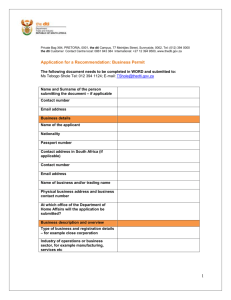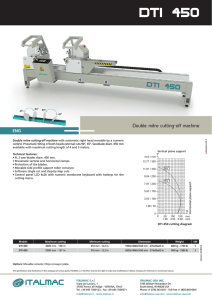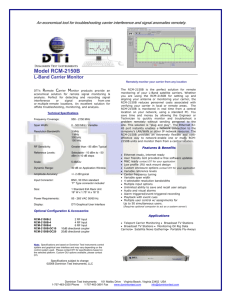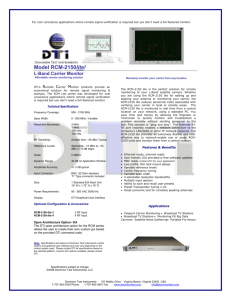Abstract
advertisement
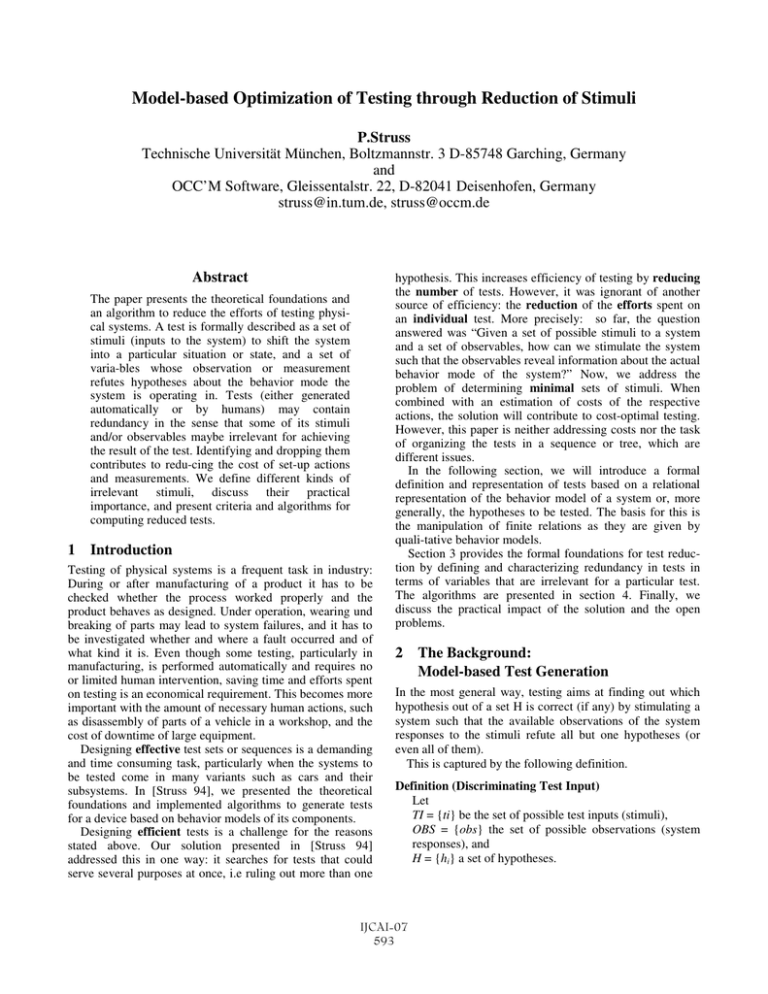
Model-based Optimization of Testing through Reduction of Stimuli
P.Struss
Technische Universität München, Boltzmannstr. 3 D-85748 Garching, Germany
and
OCC’M Software, Gleissentalstr. 22, D-82041 Deisenhofen, Germany
struss@in.tum.de, struss@occm.de
Abstract
The paper presents the theoretical foundations and
an algorithm to reduce the efforts of testing physical systems. A test is formally described as a set of
stimuli (inputs to the system) to shift the system
into a particular situation or state, and a set of
varia-bles whose observation or measurement
refutes hypotheses about the behavior mode the
system is operating in. Tests (either generated
automatically or by humans) may contain
redundancy in the sense that some of its stimuli
and/or observables maybe irrelevant for achieving
the result of the test. Identifying and dropping them
contributes to redu-cing the cost of set-up actions
and measurements. We define different kinds of
irrelevant stimuli, discuss their practical
importance, and present criteria and algorithms for
computing reduced tests.
1 Introduction
Testing of physical systems is a frequent task in industry:
During or after manufacturing of a product it has to be
checked whether the process worked properly and the
product behaves as designed. Under operation, wearing und
breaking of parts may lead to system failures, and it has to
be investigated whether and where a fault occurred and of
what kind it is. Even though some testing, particularly in
manufacturing, is performed automatically and requires no
or limited human intervention, saving time and efforts spent
on testing is an economical requirement. This becomes more
important with the amount of necessary human actions, such
as disassembly of parts of a vehicle in a workshop, and the
cost of downtime of large equipment.
Designing effective test sets or sequences is a demanding
and time consuming task, particularly when the systems to
be tested come in many variants such as cars and their
subsystems. In [Struss 94], we presented the theoretical
foundations and implemented algorithms to generate tests
for a device based on behavior models of its components.
Designing efficient tests is a challenge for the reasons
stated above. Our solution presented in [Struss 94]
addressed this in one way: it searches for tests that could
serve several purposes at once, i.e ruling out more than one
hypothesis. This increases efficiency of testing by reducing
the number of tests. However, it was ignorant of another
source of efficiency: the reduction of the efforts spent on
an individual test. More precisely: so far, the question
answered was “Given a set of possible stimuli to a system
and a set of observables, how can we stimulate the system
such that the observables reveal information about the actual
behavior mode of the system?” Now, we address the
problem of determining minimal sets of stimuli. When
combined with an estimation of costs of the respective
actions, the solution will contribute to cost-optimal testing.
However, this paper is neither addressing costs nor the task
of organizing the tests in a sequence or tree, which are
different issues.
In the following section, we will introduce a formal
definition and representation of tests based on a relational
representation of the behavior model of a system or, more
generally, the hypotheses to be tested. The basis for this is
the manipulation of finite relations as they are given by
quali-tative behavior models.
Section 3 provides the formal foundations for test reduction by defining and characterizing redundancy in tests in
terms of variables that are irrelevant for a particular test.
The algorithms are presented in section 4. Finally, we
discuss the practical impact of the solution and the open
problems.
2 The Background:
Model-based Test Generation
In the most general way, testing aims at finding out which
hypothesis out of a set H is correct (if any) by stimulating a
system such that the available observations of the system
responses to the stimuli refute all but one hypotheses (or
even all of them).
This is captured by the following definition.
Definition (Discriminating Test Input)
Let
TI = {ti} be the set of possible test inputs (stimuli),
OBS = {obs} the set of possible observations (system
responses), and
H = {hi} a set of hypotheses.
IJCAI-07
593
ti ∈ TI is called a definitely discriminating test input for
H if
⊥
(i) ∀ hi ∈ H ∃ obs ∈ OBS ti ∧ hi ∧ obs
and
(ii) ∀ hi ∈ H ∀ obs ∈ OBS
if ti ∧ hi ∧ obs ⊥
then ∀ hj ≠ hi ti ∧ hj ∧ obs ⊥.
ti is a possibly discriminating test input if
(ii´) ∀ hi ∈ H ∃ obs ∈ OBS such that
ti ∧ hi ∧ obs ⊥
and ∀ hj ≠ hi ti ∧ hj ∧ obs ⊥.
In this definition, condition (i) expresses that there exists
an observable system response for each hypothesis under
the test input. It also implies that test inputs are consistent
with all hypotheses. i.e. we are able to apply the stimulus,
because it is causally independent of the hypotheses.
Condition (ii) formulates the requirement that the resulting
observation guarantees that at most one hypothesis will not
be refuted, while (ii’) states that each hypothesis may
generate an observation that refutes all others.
Usually, one stimulus is not enough to perform the discrimination task which motivates the following definition.
Definition (Discriminating Test Input Set)
{tik} = TI´ ⊂ TI is called a discriminating test input set
for H = {hi} if
∀ hi, hj with hi ≠ hj ∃ tik ∈ TI´ such that
tik is a (definitely or possibly) discriminating test input
for {hi, hj}.
It is called definitely discriminating if all tik have this
property, and possibly discriminating otherwise. It is
called minimal if it has no proper subset TI´´⊂ TI´ which
is discriminating.
Such logical characterizations (see also [McIlraith-Reiter
92]) are too general to serve as a basis for the development
of an appropriate representation and algorithms for test
generation. Here, the hypotheses correspond to assumptions
about the correct or possible faulty behavior of the system to
be tested. They are usually given by equations and implemented by constraints, and test inputs and observations can
be described as value assignments to system variables.
The system behavior is assumed to be characterized by a
vector
vS = (v1, v2, v3, … , vn)
of system variables with domains
DOM(vS) =
DOM(v1) × DOM(v2) × DOM(v3) × … × DOM(vn).
Then a hypothesis hi ∈ H is given as a relation
Ri ⊆ DOM(vS).
Observations are value assignments to a subvector of the
variables, vobs, and also the stimuli are described by
assigning values to a vector vcause of susceptible (“causal” or
input) variables. We make the reasonable assumption that
we always know the applied stimulus which means the
causal variables are a subvector of the observable ones:
vcause ⊆ vobs ⊆ {vi}
Since the focus of this paper is not on test generation and
our solution to test reduction is independent of the way the
tests were produced, we only briefly summarize the
foundation for automated model-based test generation and
refer to for [Struss 94] details. The basic idea is to construct
test inputs by computing them from the observable
differences of the relations that represent the various
hypotheses. Figure 1 illustrates this. Firstly, for testing, only
the observables matter. Accordingly, Figure 1 presents only
the projections, pobs(Ri), pobs(Rj), of two relations, R1 and R2,
(possibly defined over a large set of variables) to the
observable variables. The vertical axis represents the causal
variables, whereas the horizontal axis shows the other
observable variables (which represent the observable
response of the system).
vcause
Not discriminable
(NTI)
Possibly discriminable
(PTI)
R1
R2
Definitely Discriminable
(DTI)
vobs\cause
Figure 1 Determining the inputs that do not, possibly,
definitely discriminate between R1 and R2
To construct a (definitely) discriminating test input, we
have to avoid stimuli that can lead to the same observable
system response for both relations, i.e. stimuli that may lead
to an observation in the intersection
pobs(Ri) pobs(Rj)
shaded in Figure 1. These test inputs we find by projecting
the intersection to the causal variables:
pcause(pobs(Ri) pobs(Rj)) .
The complement of this is the complete set of all test
inputs that are guaranteed to produce different system
responses under the two hypotheses:
DTIij = DOM(vcause) \ pcause(pobs(Ri) pobs(Rj)) .
Lemma 1
If hi=Ri, hj=Rj, TI=DOM(vcause), and OBS=DOM(vobs),
then DTIij is the set of all definitely discriminating test
inputs for {hi, hj}.
Please, note that we assume that the projections of Ri and
Rj cover the entire domain of the causal variables which
corresponds to condition (i) in the definition of the test
input.
We only mention the fact, that, when applying tests in
practice, one may have to avoid certain stimuli because they
carry the risk of damaging or destroying the system or to
create catastrophic effects as long as certain faults have not
IJCAI-07
594
been ruled out. In this case, the admissible test inputs are
given by some set Radm ⊆ DOM(vcause), and we obtain
DTIadm, ij = Radm \ pcause(pobs(Ri) pobs(Rj)) .
In a similar way as DTIij, we can compute the set of test
inputs that are guaranteed to create indistinguishable
observable responses under both hypotheses, i.e. they
cannot produce observations in the difference of the
relations:
(pobs(Ri) \ pobs(Rj)) ∪ (pobs(Rj) \ pobs(Ri)).
Then the non-discriminating test inputs are
NTIij =
DOM(vcause)\ pcause((pobs(Rj)\ pobs(Ri)) ∪ (pobs(Ri)\ pobs(Rj)))
All other test inputs may or may not lead to discrimination.
Lemma 2
The set of all possibly discriminating test inputs for a pair
of hypotheses {hi, hj} is given by
PTIij = DOM(vcause)\ (NTIij ∪ DTIij ) .
The sets DTIij for all pairs {hi, hj} provide the space for
constructing (minimal) discriminating test input sets.
Lemma 3
The (minimal) hitting sets of the set {DTIij} are the
(minimal) definitely discriminating test input sets.
A hitting set of a set of sets {Ai} is defined by having a
non-empty intersection with each Ai. (Please, note that
Lemma 3 has only the purpose to characterize all
discriminating test input sets. Since we need only one test
input to perform the test, we are not bothered by the
complexity of computing all hitting sets.)
This way, the number of tests constructed can be less than
the number of necessary pairwise discrimination between n
hypotheses, n2 - n. If the tests have a fixed cost associated,
then the cheapest test set can be found among the minimal
sets. However, it is worth noting that the test input sets are
the minimal ones that guarantee the discrimination among
the hypotheses in H. In practice, only a subset of the tests
may have to be executed, because some of them refute more
hypotheses than guaranteed (because they are a possibly
discriminating test for some other pair of hypotheses) and
render other tests unnecessary.
The computation is based on operations on relations, such
as intersection and projection, and will usually practically
work only on finite relations. Qualitative abstraction can
generate such representations for continuous models and,
hence, enable a broad applicability of the algorithm. The
many existing test generation algorithms for digital circuits
are specializations of it (provided they are sound and
complete). Of course, they can exploit the special Boolean
domain and, hence, may be more efficient than our general
algorithm.
The algorithm has been implemented based on
commercial software components of OCC’M’s RAZ’R
([OCC’M 05]) which provide a representation and
operations of relations as ordered multiple decision
diagrams (OMDD). The input is given by constraint models
of correct and faulty behavior of components taken from a
library which are aggregated according to a structural
description. These models are the same ones that can and
have been used for model-based diagnosis and detectability
and discriminability analysis.
It is important to note that the required operations on the
relations are applied to the observable variables only
(including the causal variables). The projection of the entire
relation Ri to this space can be understood as producing a
black box model that directly relates the stimuli and the
observable response. In many relevant applications, this
space will be predefined and small. For instance, when
testing of car subsystems exploits the on-board actuators
and sensors only, this may involve some 10 - 20 variables or
so. The entire workshop diagnosis task has more potential
probing points, but still involves only a small subset of the
variables in the entire behavior relation Ri.
Finally, we mention that probabilities (of hypotheses and
observations) can be used to optimize test sets ([Struss 94a],
[Vatcheva-de Jong-Mars 02]).
3 Different Kinds of Irrelevant Causal
Variables
In the tests characterized by Lemma 1, test inputs are tuples
of values for all available causal variables, and the
guarantee for discrimination is related to all specified
observables. However, it may be the case, that a generated
test is redundant in the sense that already of subset of inputs
and/or observations would provide the same information for
discrimination. This is important, because costs are often
related to the number of stimuli and observation actions. If
we can reduce individual tests to the necessary stimuli
and/or observations only, this will contribute to reducing
costs for testing.
In the following, we will provide the foundations for
reducing the set of input variables. More details can be
found in [Strobel 04].
Let DTIij ⊆ DOM(vcause) be the set of definitely discriminating test inputs. The question is whether there is a
subvector v’cause ⊆ vcause that can be ignored in some way
without losing discrimination information provided by the
test. Rather than computing the set of test inputs for various
subsets of the causal variables to answer this question, we
will identify irrelevant causal variables by analyzing DTIij.
A closer look reveals that a causal variable can be
irrelevant in different ways that have a different impact on
the generation and application of tests. Let us first illustrate
these cases by simple examples and then define them
formally.
Suppose you want to test whether the light bulb L in the
tiny circuit of Figure 2 works or is defect (open). The
possible stimuli are opening and closing of switches S1 and
S2, and L can be observed. If we assume that resistor R is
not too small, all one has to do is close S1 and observe
whether or not L is lit (assuming there is a voltage supply).
For this test, the position of S2 is totally irrelevant:
whatever its state may be, it does not influence the actions
we have to perform.
IJCAI-07
595
S1
v’cause
L
v’cause
v’cause
S2
DTI
DTI
DTI
R
Figure 2 The position of S1 is totally irrelevant for
testing L
(i)
Regarding the circuit in Figure 3, we can observe the
following: the position of switch S1 is irrelevant in the sense
that we can test lamp L regardless of whether it is up or
down. However, it is not totally irrelevant: in contrast to the
first case, the appropriate test inputs depend on the position.
For S1 up, S2 must be closed; otherwise, S3 has to be
closed. This means, the position of S1 has to be known in
order to perform a test, but it does not have to be influenced
which allows for omission of an action. We call such a
variable weakly irrelevant (in the lack of a better term).
The same circuit can be used to illustrate a third kind of
irrelevance of a causal variable: the position of S2 is
irrelevant if S1 is in down position. Hence, it is not totally
irrelevant, but only under certain conditions. This is still
S2
L
S1
S3
vcause\ v’cause
(ii)
vcause\ v’cause
(iii)
vcause\ v’cause
Figure 4 Abstract examples of total irrelevance (i),
weak irrelevance (ii), and conditional irrelevance (iii)
covers the entire domain. And case (iii) implies that DTI has
a subset that is obtained as the cross product DOM( v’cause)
and a set of tuples of the remaining variables (indicated by
dotted lines in Figure 4).
This motivates the following definitions:
Definition (Irrelevance of causal variables)
Let DTI ⊂ DOM(vcause) be the complete set of definitely
discriminating test inputs for two hypotheses. A subset of
causal variables v’cause ⊆ vcause is called:
(i) totally irrelevant if
DTI = pvcause\v’cause (DTI) x DOM(v’cause)
(ii) weakly irrelevant if
pv’cause (DTI) = DOM(v’cause)
(iii) conditionally irrelevant if there is a non-empty
subset DTI’⊂ DTI such that
DTI’ = pvcause\v’cause (DTI’) x DOM(v’cause)
As suggested by Figure 4, there are implication relations
among the three types of irrelevance, which can be easily
proved based on the above definition.
Figure 3 The position of S1 is weakly irrelevant;
positions of S2 and S3 are conditionally
practically important, because once the condition is
satisfied, we can save by avoiding actions related to S2’s
position. This variable is conditionally irrelevant, and so is
S3’s position, of course.
To generalize the intuition gained from the examples and
to formalize them: for some subvector v’cause ⊆ vcause we
distinguish the following cases (for which Figure 4 shows
abstract examples): for all value assignments from
DOM(v’cause), DTIij can contain
i.
the same set of stimuli for the remaining causal
variables (total irrelevance)
ii.
some set of stimuli for the remaining causal
variables (weak irrelevance)
iii.
the same set of stimuli for the remaining causal
variables under some restriction of the values of
the remaining causal variables (conditional
irrelevance).
Figure 4 displays the sets DTI in the plain of causal
variables (not the plain of all observables as Figure 1),
where the vertical axis corresponds to the irrelevant variable
(or subvector of variables) v’cause, while the horizontal axis
represents the remaining ones. In case (i), DTI is the cross
product of the entire domain of v’cause and a certain value
assignment to the remaining variables. Case (ii) can be
characterized by the fact that the projection of DTI to v’cause
Lemma 4
If v’cause is totally irrelevant
v’cause is also conditionally irrelevant.
If v’cause is conditionally irrelevant
v’cause is also weakly irrelevant.
The goal of identifying sets of irrelevant causal variables
seems to imply that one has to consider the power set of the
causal variables. However, this is not the case due to the
following lemma.
Lemma 5
(v1) and (v2) are both totally irrelevant
⇔ v’cause = (v1, v2) is totally irrelevant.
(v1) and (v2) are both weakly irrelevant
⇔ v’cause = (v1, v2) is weakly irrelevant.
This allows us to investigate this kind of irrelevance
independently for each variable and then comprise them in
one set, which makes the check linear in the number of
causal variables. However, a similar lemma does not apply
to conditionally irrelevant variables.
Remark
If (v1) and (v2) are both conditionally irrelevant, then
v’cause = (v1, v2) is not necessarily conditionally irrelevant.
Obviously, to establish conditional irrelevance of the pair
of variables, the conditions for the irrelevance of the two
IJCAI-07
596
variables would have to have a non-empty intersection. But
Figure 3 provides an example in which they are even
exclusive: the position of S2 is irrelevant under conditions
that require a particular state of S3 and vice versa.
4 Test Reduction
Based on the definitions and lemmata in the previous section, we developed algorithms for the automated reduction
of tests. Whether they have been generated by an algorithm
like the one sketched in section 2 or by human experts is
irrelevant, as long as they can be represented in the relational style.
Firstly, we exploit lemma 5: we start with the test input
set for a maximal set of causal variables and then analyze
irrelevance of each single causal variable.
Secondly, we check for weak irrelevance first, because
lemma 4 allows ruling out also the other kinds of irrelevance in the negative case. This check can be based directly
on the definition of weak irrelevance and is formally described as follows.
Lemma 6
Let vk be a causal variable, pk the projection to this
variable, and DTI a set of definitely discriminating test
inputs.
If pk (DTI) = DOM (vk)
then vk is weakly irrelevant to DTI.
If pk (DTI) ≠ DOM (vk)
then vk is not weakly, conditionally, or totally
irrelevant to DTI.
In case of a weakly irrelevant variable we can check for
conditional and total irrelevance. To get the idea underlying
this test, a glance at the abstract example of Figure 4 may be
helpful. We have to check whether there exists a non-empty
DTI´ ⊂ DTI such that
p-k (DTI´ ) × Dom(Vk) ⊂ DTI´,
where p-k is the projection to the causal variables except vk:
vcause\ {vk}.
We do so by computing the projection of the maximal DTI´
DTI´-k := p-k (DTI´)
and checking whether it is empty, and we compute it by
computing its complement.
DTI´-k comprises all value assignments to vcause\{vk} that
when combined with arbitrary values of vk always yield a
test input of DTI. Hence, its complement contains all value
assignments that can be combined with at least one value of
vk to yield a test input that does not lie in DTI, but in its
complement:
DOM(vcause\{vk})\ DTI´-k =
{v-k,0 ∈DOM(vcause\{vk}) ∃ vk,0 ∈DOM(vk) ∧
v-k,0 ° vk,0 ∈ DOM(vcause)\ DTI}.
But this is the projection of the complement of DTI:
p-k (DOM(vcause)\ DTI).
This yields the following lemma which underlies the second
check.
Lemma 7
Let vk be a causal variable, p-k the projection to the other
causal variables, and DTI a non-empty set of definitely
discriminating test inputs. Furthermore, let
DTI´-k :=
DOM(vcause\ {vk})\ p-k ( DOM(vcause)\ DTI ).
If DTI´-k = ∅
then vk is not conditionally or totally irrelevant to DTI.
If DTI´-k ≠ ∅
then vk is conditionally irrelevant to DTI
If DTI´-k = p-k (DTI)
the vk is totally irrelevant to DTI.
Please note that DTI´-k represents the condition under
which vk is irrelevant. This can be used for investigating the
relationship of these conditions for different causal variables. The third implication of the lemma simply reflects the
fact that total irrelevance is obtained if the condition comprises all value assignments to the other causal variables that
occur in DTI.
This establishes an algorithm for determining whether a
causal variable is irrelevant and if so, of what type:
IF pk (DTI) = DOM(vk)
THEN
IF DTI´-k = ∅
THEN “WEAKLY IRRELEVANT”
ELSE IF DTI´-k = p-k (DTI)
THEN ”TOTALLY IRRELEVANT”
ELSE “IRRELEVANT UNDER DTI´-k”
ELSE “NOT IRRELEVANT”
Based on the results of this algorithm, the irrelevant
variables can be removed from DTI by projection yielding a
simplified and cheaper test input set.
What we have presented for the case of definitely
discriminating test input sets can obviously be applied in the
same way to possibly discriminating test inputs.
5 Discussion and Future Challenges
The generation of a set of test input sets (with or without the
reduction described here) provides the starting point for
different further processing and use of this information. One
can select one test input from each set and generate a fixed
sequence or decision tree of tests to be applied. The
information could also be used in a dynamic way by making
the choice of the next test dependent on the current
situation. A characterization of the situation can involve two
aspects: firstly, the hypotheses actually refuted so far. We
emphasize again, that this is not completely fixed by the
tests executed so far, because some of them may have
refuted all hypotheses that they can discriminate, and also
they may have refuted more hypotheses than were
guaranteed to be refuted. Secondly, one can choose the next
test based on the current state of the system in order to
minimize the number of stimuli that have to be changed.
The different types of irrelevance have a different
impact on these strategies. Obviously, totally irrelevant
IJCAI-07
597
variables can be eliminated from the respective test inputs,
i.e. they do not have to be considered for the respective test
actions. However, unless they are irrelevant to all test input
sets in the set, they have to be observed during the testing,
because they may be weakly irrelevant to some other test
input sets and, hence, their value has to be known in order to
determine the appropriate values for the other causal
variables.
Weakly irrelevant variables do not have to be influenced
either in the respective test, but the appropriate values for
the other variables have to be determined by restricting DTI
for the next step to the current values of the weakly
irrelevant variables.
For conditionally irrelevant variables, it has to be checked
whether the irrelevance condition DTI´-k is satisfied in the
current situation, and if so, they do not have to be touched,
and an arbitrary assignment of values out of DTI´-k can be
chosen for the relevant variables.
In this paper, we focused on the reduction of the number
and costs of stimuli actions. This is justified because their
costs are often higher than those of observing the system
response. Reducing also the cost associated with
observations is nevertheless a task that needs to be
addressed. However, the solution for the causal variables
does not simply carry over, and the tasks are not
independent: in principle, a reduction of the set of
observables may require the presence of certain stimuli and
vice versa.
Another challenge is to investigate how serious a
fundamental limitation of our approach is (and to overcome
it if necessary and possible): the behavior representation in
terms of relations and, hence, a rather static view on the
system to be tested. If dynamic features are relevant, they
can be accommodated by including derivatives in the set of
model variables. Another solution is to base the behavior
representation on transitions. Since they can be represented
again by relations (linking the states “before” and “after”)
the described representations and algorithms remain
applicable.
We have explored the latter solution by transforming
models given as finite state machines into such a
representation with the goal of extending the solution to
testing of software [Esser-Struss 07]. This provides a
challenge in itself, mainly because of the difficulty in
establishing appropriate fault hypotheses: While for many
physical devices, such hypotheses are determined by the
ways the components wear and fail, the ways in which
software can fail spans an infinite space and may include
structural faults. An extension of the test generation and
reduction methods to include software would be highly
attractive because it would allow testing embedded software
and its physical context in an integrated way.
Acknowledgements
Thanks to Torsten Strobel who implemented the
algorithm, Oskar Dressler for discussions and support of
this work, and the Model-based Systems and Qualitative
Modeling Group at the Technical University of Munich.
This work was supported in part by Audi AG, Ingolstadt.
References
[Esser-Struss 07] Esser, M., Struss, P.: Fault-model-based
Test Generation for Embedded Software. In: Proceedings
of the 20th International Joint conference on Artificial
Intelligence IJCAI-07, Hyderabad, India, 2007
[McIlraith-Reiter 92] McIlraith, S., Reiter, R.: On Tests for
Hypothetical Reasoning. In: W. Hamscher, J. de Kleer
und L. Console (Hg.). Readings in Model-based
Diagnosis: Diagnosis of Designed Artifacts Based on
Descriptions of their Structure and Function. Morgan
Kaufmann, San Mateo, 1992
[OCC’M 05] www.occm.de
[Strobel 04] Strobel, T., Ein Algorithmus zur Optimierung
automatischer, modellbasierter Testfallgenerierung,
Diploma Thesis, Techn. Univ. Munich, 2004 (in
German)
[Struss 94] Struss, P.: Testing Physical Systems. In:
Proceedings of AAAI-94, Seattle, USA, 1994.
[Struss 94a] Struss, P.: Testing for Discrimination of
Diagnoses. In: Working Papers of the 5th International
Workshop on Principles of Diagnosis (DX-94), New
Paltz, USA, 1994.
[Vatcheva-de Jong-Mars 02] Vatcheva, I., de Jong, H.,
Mars, N.: Selection of Perturbation Experiments for
Model Discrimination. Proceeddings of ECAI-02, 2002
IJCAI-07
598
